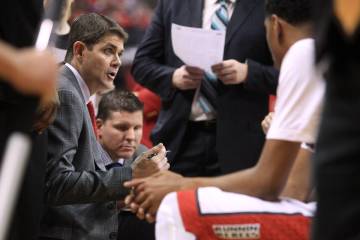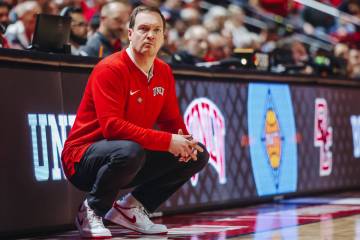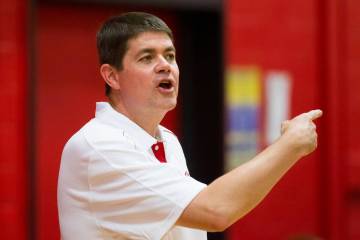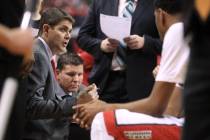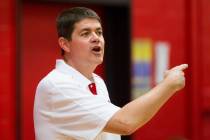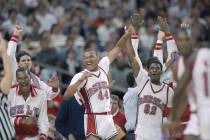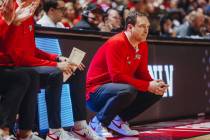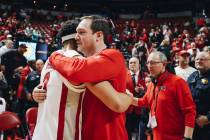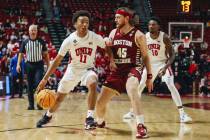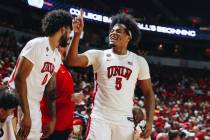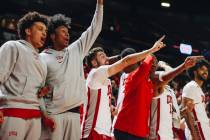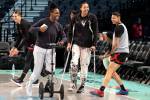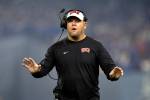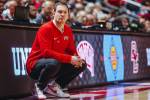Cage has no time for pain
Two days after his left knee was cut open and his partially torn patellar tendon was repaired, UNLV freshman Troy Cage started his rehabilitation. But that was not his plan.
It was a Sunday, and he was expecting some recovery and relaxation time.
Rebels athletic trainer Dave Tomchek had other ideas. He had a workout schedule ready for Cage, who got off the couch -- with the help of crutches -- and on the training table.
"I was saying, 'I just had surgery.' But Tomchek wasn't really hearing that," said Cage, a 6-foot-5-inch shooting guard. "He was trying to get me back on the floor and playing, and I really thank him for that.
"He just pushed me harder and harder every day. He just kept pushing me and pushing me, and I'm here now."
Cage's surgery was Oct. 12, the day UNLV opened basketball practice, and his return was targeted for three months. But mostly because of his aggressive approach to rehab, he was cleared to practice Dec. 3, one month ahead of schedule.
Cage probably won't play Wednesday, when the Rebels (7-2) host 21st-ranked Arizona (6-2), but he should be on the floor for the Dec. 22 game against Tennessee-Martin.
After sitting out last year as a redshirt, Cage was eager to see game action. The injury news he received in October was crushing.
"I was heartbroken by that," he said. "I had a lot of down days when I found out."
Instead of defending Wink Adams in practice, Cage reported for basic training with Tomchek.
On the first day of rehab, Tomchek put Cage through simple range-of-motion exercises. After seven to 10 days, he was free of crutches.
By the third or fourth week, Cage was jumping and landing. At the six-week stage, he started running.
"The first day I started to run, I kind of thought to myself that I wouldn't be able to do it," Cage said.
Support from his parents and UNLV coaches and teammates helped Cage overcome the emotional disappointment. Tomchek helped him clear the hurdle of self-doubt.
"The mental aspect of the rehabilitation is something that you really have to coach them through," Tomchek said. "He had the fear of God in his eyes that he didn't want to do a certain movement because it's going to tear again. He was apprehensive."
In the process, and through the pain, he discovered something about himself -- he enjoyed the challenge of rehab.
"I kept telling Tomchek, 'Give me more, give me more,' and I think he really liked that about me," Cage said.
Before the Rebels' game at UC Santa Barbara on Nov. 27, Tomchek tossed up a ball and told Cage to dunk it. Cage, who has a running vertical leap of 38 inches, slammed it.
"That's when I knew he was there," Tomchek said. "I tell them what to do, but they do the rehab. Troy had the desire, and he wanted to get after it. There were times when I had to slow Troy down.
"When you've got a kid like that who's eager to play and does what you ask him to do, rehabs are easy."
Tougher for Cage might be finding playing time in a rotation already 10 players deep.
"It looks like Troy's moving around pretty good, and I think he's ready to go," UNLV coach Lon Kruger said. "We'll have quality depth, especially on the perimeter, and we'll play a lot of guys."
Cage, who averaged 19 points per game as a high school senior in Baton Rouge, La., said he's eager to help out the teammates who supported him through the first injury of his career.
"I don't expect big minutes or anything. It's all about what I do in practice and what the coaches see I can do to help the team," he said. "I don't have any doubts because I had knee surgery. I'm ready to play."
Contact reporter Matt Youmans at myoumans@reviewjournal.com or (702) 387-2907.
UNLV Basketball





